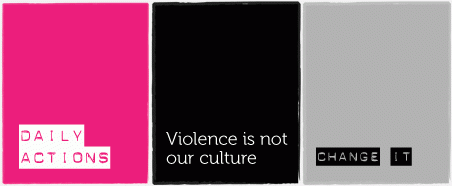
Cultural norms and attitudes support the perpetuation of violence against women in hidden and explicit ways. Hidden, when sexism and discriminatory attitudes based on gender and sexuality are accepted and reinforced in our everyday lives. For example, when a sexist joke is carelessly forwarded over email that strengthens the idea that girls are inept in every field, even the kitchen. Or when women’s value can be summarily judged by the colour of her hair, or a man’s by how well he can control “his woman” in the bedroom.
Explicit, when culture and religion are used as an excuse to tolerate and accept acts of violence against women. For example, in the case of violence by police against transgender women for breaching “natural” gender codes deemed appropriate by those who hold power over religious interpretation in the community. Or in the case of “honour” killing, when women are murdered for seemingly violating communal “honour” codes that expect women to abide by normative ideas of morality and sexual submission at the cost of their right to personal autonomy and decision-making. What is the role of ICT?
The internet creates spaces where conversations happen, groups of people with shared interests come together and a multitude of information proliferates. This means that ideas about culture, norms and practices are constantly exchanged and contested everyday by the millions of users who engage online. Popular social networking platforms like Facebook have also enabled the creation of groups that support or advocate for particular cultural norms and ideas. This means that communities such as those which advocate to stop violence co-exist with those that argue for ways to engage in rape.
There are also cultural practices in the use of technology that are steeped in gendered ideas about the role and value of women and men. For example, women and girls are seen as passive users with little knowledge on how technology works, while men and boys are imagined as the norm for developers, techies and hackers. These ideas help to prop up technology-related VAW like online harassment and cyberstalking. Internet tools and applications for hacking passwords and tracking online activities often assume a male audience, or encourage a culture of surveillance that supports cyberstalking. And prominent women bloggers are regularly subjected to online abuse and violent threats that attack their sexuality and right to express an opinion, especially when it is related to fields where men have traditionally been held as experts, such as gaming, politics and technology. However, many have decided to break the silence and shame their harrassers by publishing the abusive comments using #threatoftheday and #mencallmethings – “to cover everything outside the threats — the slurs, the rape fantasies, the hate mail”.
Exercise your right to participate in the shaping of culture. Know it, define it, demand change!
1) MAP IT
- Identify online spaces that encourage a culture of VAW.
- This can be Facebook groups that advocate for sexual violence such as those identified through this initiative, or forums and websites that promote sexism and discrimination through its topics or representation of women and girls.
- Capture a printscreen of the site.
- Document these spaces by submitting a report on the TBTT map.
- Click on “Submit a report”.
- Write a description of the space and why you think it supports a culture of VAW online.
- Tick “culturally-justified VAW” under the “Type of VAW” category, and tick other options where applicable.
- Mark on the map the region the site is focussing on, or if it is global, the town/city where you are (do not write your home address or street address, just a broad area or landmark will do).
- Upload the printscreen as part of your report.
2) SHARE YOUR STORY
- If you have experienced culturally-justified violence online - such as comments on your blog telling you to accept abuse that targets your gender or sexuality because it is part of online culture - share your story.
- Add your story to the map by submitting a report using the same steps above.
- Check the map for reports of cases and read the stories.
- Extend your support by leaving a comment, or by sharing your own experience.
- Participate and engage in conversations to advocate for a violence-free culture in the online spaces that you occupy.
- Grow the call and spread the word. If you’re on Twitter, tweet your thoughts and responses. Use the #mencallmethings and #threatoftheday hashtags to publish the abusive comments too.Gather users who believe in creating an online environment and culture that anchors on respect for rights, and amplify your stand. Grow the call by using the #takebackthetech and #16days hashtag.
Participate and collectively build a loud of body of evidence to mark the extent of culturally-justified VAW that happens online. Make the invisible visible!
- Log in to post comments
